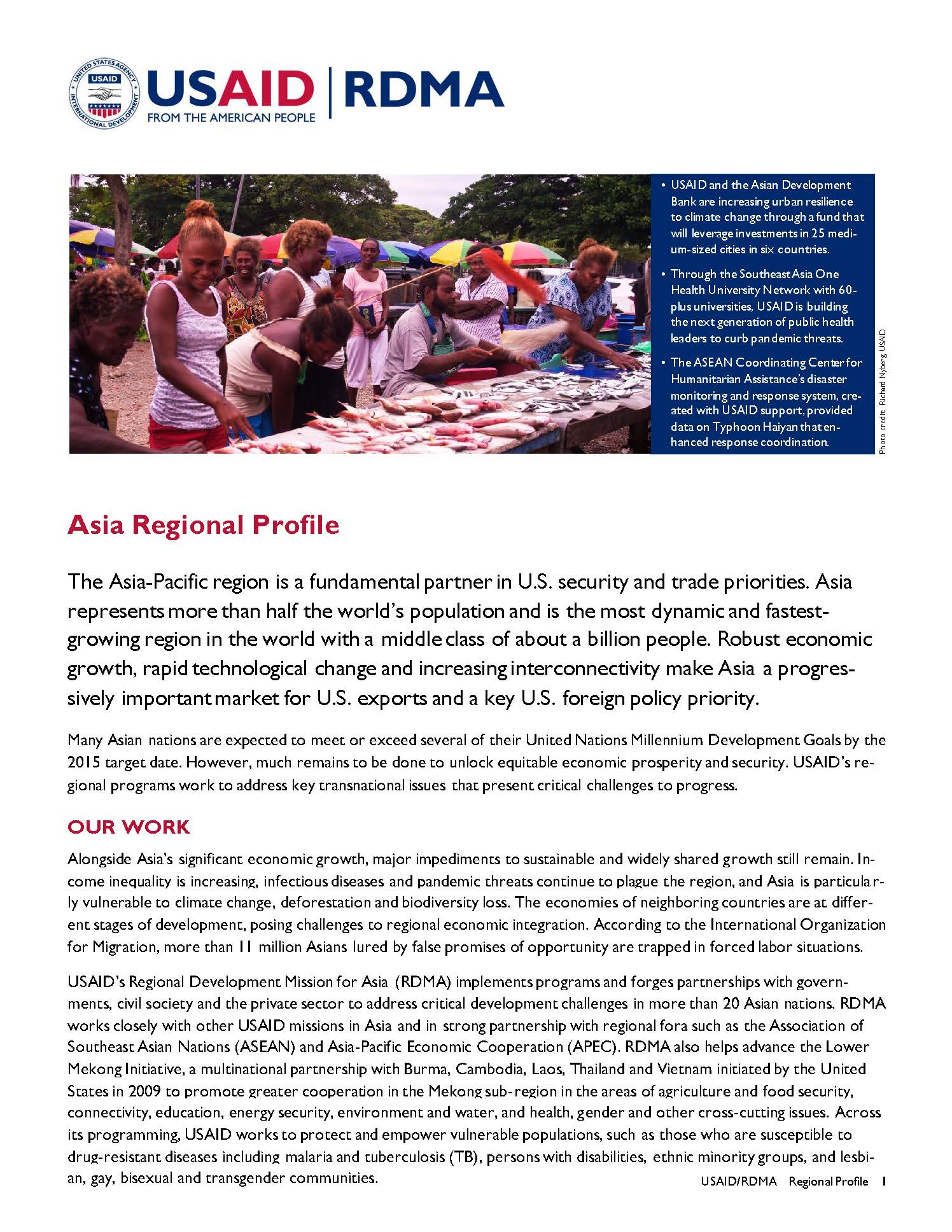The Asia-Pacific region is a fundamental partner in U.S. security and trade priorities. Asia represents more than half the world’s population and is the most dynamic and fastest-growing region in the world with a middle class of about a billion people. Robust economic growth, rapid technological change and increasing interconnectivity make Asia a progressively important market for U.S. exports and a key U.S. foreign policy priority.
Many Asian nations are expected to meet or exceed several of their United Nations Millennium Development Goals by the 2015 target date. However, much remains to be done to unlock equitable economic prosperity and security. USAID’s regional programs work to address key transnational issues that present critical challenges to progress.
OUR WORK
Alongside Asia’s significant economic growth, major impediments to sustainable and widely shared growth still remain. Income inequality is increasing, infectious diseases and pandemic threats continue to plague the region, and Asia is particularly vulnerable to climate change, deforestation and biodiversity loss. The economies of neighboring countries are at different stages of development, posing challenges to regional economic integration. According to the International Organization for Migration, more than 11 million Asians lured by false promises of opportunity are trapped in forced labor situations.
USAID’s Regional Development Mission for Asia (RDMA) implements programs and forges partnerships with governments, civil society and the private sector to address critical development challenges in more than 20 Asian nations. RDMA works closely with other USAID missions in Asia and in strong partnership with regional fora such as the Association of Southeast Asian Nations (ASEAN) and Asia-Pacific Economic Cooperation (APEC). RDMA also helps advance the Lower Mekong Initiative, a multinational partnership with Burma, Cambodia, Laos, Thailand and Vietnam initiated by the United States in 2009 to promote greater cooperation in the Mekong sub-region in the areas of agriculture and food security, connectivity, education, energy security, environment and water, and health, gender and other cross-cutting issues. Across its programming, USAID works to protect and empower vulnerable populations, such as those who are susceptible to drug-resistant diseases including malaria and tuberculosis (TB), persons with disabilities, ethnic minority groups, and lesbian, gay, bisexual and transgender communities.
GLOBAL CLIMATE CHANGE AND ENVIRONMENT
Global climate change, illegal wildlife trafficking and natural resource mismanagement are among the chief impediments to Asia’s long-term sustainability. USAID helps communities adapt to the changing environment and mitigate the negative impacts of global climate change through initiatives focused on green, low-emission development, adoption of clean energy policies, and the sustainable management of forests and wetlands. USAID also promotes climate-resilient agriculture and infrastructure development, and sustainable and equitable methods to reduce urban climate change risks. Activities reduce the demand for illegal wildlife products while increasing law enforcement’s capabilities to combat wildlife trafficking through training and international cooperation. USAID increases food security for more than 120 million people by improving conservation management of key Asia-Pacific fishery sites. We work in some of the world’s most important marine biodiversity areas, such as the Coral Triangle, which supplies more than one-tenth of the world’s seafood. Food security is further strengthened by efforts to protect Mekong River fisheries and enhance sustainable aquaculture production.
GLOBAL HEALTH
USAID helps improve health systems which are vital to combatting the spread of infectious diseases. Targeting HIV-affected populations in Laos and Thailand, USAID works with host country health providers to implement state-of-the-art prevention, care and treatment programs. USAID also helps Asia-Pacific countries address the spread of TB and multidrug-resistant TB by: introducing new, faster diagnostic tools; providing training and equipment to strengthen lab systems; and advancing cutting-edge research. To control the occurrence and spread of drug-resistant malaria, USAID programs promote insecticide-treated bed nets, drug quality control and disease surveillance. Underscoring the urgency of the situation, the governments of Burma, Thailand and the United States have launched their first cooperative effort to reduce drug-resistant malaria along the Thai-Burma border.
ECONOMIC GROWTH AND TRADE
USAID enhances regional integration and fosters inclusive economic growth in Southeast Asia in partnership with ASEAN and APEC by supporting regional policy dialogues and standards. Supporting ASEAN’s goal of economic integration, USAID helps enable efficient, transparent and sustainable trade practices and facilitate regularized labor mobility. Through the development of an agricultural learning platform, RDMA is also working to enable farmers in Bangladesh, Cambodia and Nepal to share and benefit from new agricultural practices and technologies.








Comment
Make a general inquiry or suggest an improvement.